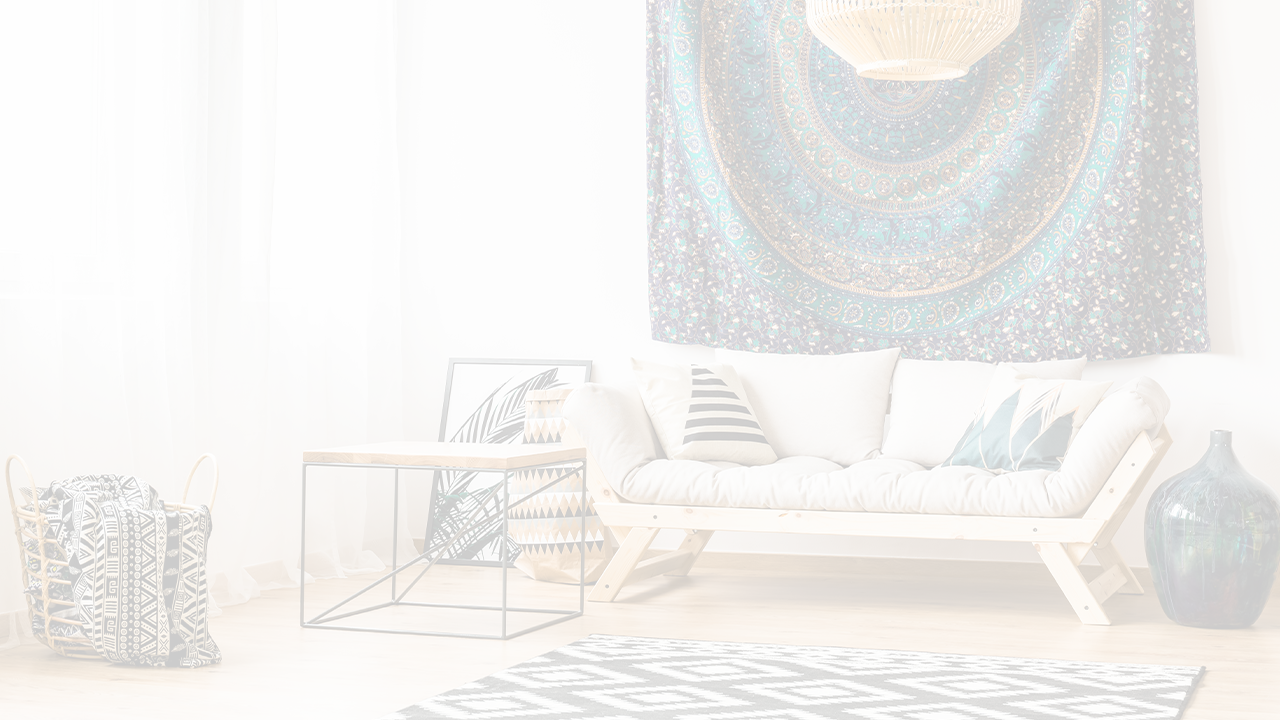All products mentioned in this article are linked below.
Let’s say you have one big, empty wall and don’t want to go through the tedious process of painting it. You could look for a fun wallpaper instead, but if you’re a renter, chances are your lease is iffy with wallpapering. Perhaps creating a gallery wall also sounds time-consuming. Getting the placements right and preparing all the materials and hardware needed for picture hanging is a lot of work. (We should know, we’ve written all about it!)
So what’s the next best thing? Tapestries! They’re a form of textile art spanning thousands of years across many cultures. They were prevalent among the European elite beginning in the Medieval period as part of a revival of religious imagery. As tapestry-making flourished, artisans started depicting heroic exploits, hunting scenes, and landscapes.

Tapestries have survived as a popular design choice until today, albeit with lighter fabrics and threads such as silk, simplified production techniques, and on a smaller scale. While it’s not the same as putting up a heavy wool piece in a Medieval castle, you can still make your home look more elegant and dignified with a modern wall tapestry.
By the time you’re done with this article, you’ll know why you should have one, how to prepare the materials, and most importantly, how to hang your own tapestry!
Why You Should Hang a Tapestry
Think of tapestries like picture frames – the bigger it gets, the more drama it can create around the room. Larger pieces eliminate the need to hang anything else because it automatically becomes the focal point. Below are three ways a tapestry piece can do so.
Tapestries add a pop of color and vibrancy.
Depending on its colors and patterns, tapestries can quickly make a room look more inviting. Mandala wall tapestries are a popular choice because the repeating patterns are almost meditative, while the vibrant colors make the whole thing look hypnotizing. It’s a great way to lend a creative aspect to your home.

Tapestries are more versatile than wallpapers.
Large tapestries are the easy, no-fuss alternative to wallpaper. While wallpapering demands a lot of preparation, tapestries only need to be hung from the wall, and voila! You now have a backdrop that’s extremely easy to change out.
If you like a lot of foliage and greenery in your interior design, tapestries can help bring the outdoors inside with earthy colors and landscape sceneries.

Tapestries can make a room look and feel bigger.
By hanging a large tapestry piece in a room, you’re establishing a focal point. Immediate attention goes to the tapestry's details and imagery instead of the room's size, making it feel more expansive. Also, because they’re hung vertically, this helps elongate the walls and create the impression of higher ceilings.
Tapestries also participate in the way colors and lighting can affect a space. If the piece has lighter colors and bright tones, they reflect light and create an airy atmosphere, which helps open up a room and add texture.

What to Do Before Hanging Your Tapestry
Because tapestries can be hung in various ways, there are some pre-hanging preparations you ought to do depending on how you want to hang your tapestry. If you’re unsure whether to use hooks, nails, or other materials, check out different ways to prepare your tapestry below.
Check how heavy your tapestry is.
Unlike antique and traditional tapestries made from thick wool, modern tapestries are significantly lighter because of the synthetic blends their fibers are made of. Smaller-sized 2x3 ft modern tapestries can weigh anywhere from a few ounces to a couple of pounds. How heavy the piece is will determine the hanging method and hardware required for mounting.
Check for attached loops and rod pockets.
Many tapestries come with built-in loops or rod pockets designed for easy hanging. Check near the top edge for any of these features. In this case, you’ll only need to find a wooden rod and nails to hold the piece.
Sew a rod pocket.
If your tapestry doesn’t have a rod pocket, you can sew one yourself. Provided it won’t ruin the design, you can fold the top edge and sew across it to create a pocket. Otherwise, you can follow this tutorial to see how you can sew a strip of fabric at the back of the piece:
Add grommets.
You may not have the skills or equipment to sew a rod pocket or a hanging sleeve, so you can add grommets as an alternative.
This method involves poking holes into the tapestry to create attachment points for hooks and reinforcing them to prevent tearing.
A grommet tool kit doesn’t cost a lot and typically comes with a hole cutter, anvil, setting tool, grommets, and everything else necessary to reinforce holes in your tapestry.
Here’s a helpful tutorial on how to add grommets:
Poke holes.
Rod pockets and adding grommets are practical choices if the fabric has a tighter weave and is prone to tearing or fraying. However, drapey fabrics with looser weaves allow pins to fit through the material without damage.
Poking holes is the easiest solution compared to the previous two, but remember to only choose this option after thoroughly checking and testing your tapestry’s fabric.
How to Hang a Tapestry
We’ve mentioned before that preparing your tapestry depends on how you want to hang the piece. Doing so can be summarized with three basic tapestry wall hangers: nails, hooks, and wires.
Nails and pushpins
This is the easiest option if your space is temporary as a dorm room is for example, and you want to hang a tapestry. If you’re hanging a small to medium-sized lightweight cloth tapestry piece, our one-step hanger has a 20-lbs maximum carrying capacity and is extremely easy to install.

1. Stretch out the tapestry across the wall and use a pencil to mark where to put the nail.
2. Hammer the nail gently into the wall. Make sure to leave a small portion of the nail exposed for hanging. Luckily, our one-step hanger nail has a flat disk just below the top specifically for this purpose.
3. If your tapestry comes with loops at the top corners, drape the tapestry across the wall and hook them onto the nails. If you don’t have the loops, refer to the section above to remedy this with grommets.

4. Leaving it at this will create an elegant drape on the wall. If it needs more support, place a row of pushpins across the top, evenly spaced apart, to hold up the fabric.
Ceiling hooks
If you have a big tapestry piece but don’t have enough wall space, bringing it further up with ceiling hooks is a great way to form a cozy corner or a reading nook in your bedroom. This method is suitable if you’re unsure how to hang a tapestry without nails.
Grid hooks are capable of carrying items up to 15 lbs, so make sure the tapestry you’re hanging on the ceiling isn’t too heavy!

1. Decide where you want to hang the tapestry from. It could be above the bed, seating area, or any other corner.
2. Ensure the ceiling area above your chosen spot is clear from any wires and sturdy enough to support the weight of the canopy.
3. Install the drop ceiling hooks.
4. Use a pair of curtain rings to connect the loops or grommeted corners of the tapestry to the ceiling hook.
Picture wire
An alternative tapestry wall hanger to use instead of stacking too many pushpins on the wall is a thread or rope. Our nylon cords are strong enough to hold items up to 20 lbs and are soft enough to not damage the fabric.

If your tapestry doesn’t come with a rod pocket and you can’t sew it on, here’s how you can get around that:
1. Check your tapestry’s fabric first if it has a loose or tight weave. If it has a loose weave, poking holes alone should be okay. Otherwise, fortify them with grommets.
2. Measure how long the tapestry is at the top. Depending on how long or short it is, you can divide it into 3-5 points to thread the cord through.
3. Mark where you can cut small slits, ensuring they’re evenly spaced apart.
4. Thread the nylon cord through the holes.

5. Hold the tapestry to the wall temporarily to see where to install the nails.
6. Hang the tapestry and secure the wire on the nail with knots.
7. Once the tapestry is securely hung, step back and assess the position. Take time to readjust if needed to ensure it hangs precisely how you pictured it. You can now enjoy the regal beauty of a tapestry in your space.
Final Thoughts
In conclusion, tapestries are an excellent addition to any room because of their ability to serve both as the visual focal point and decorative backdrop. The effect also relies a lot on how you choose to hang it.
If you plan to hang a tapestry using the methods we’ve discussed, we would be thrilled to see how it looks! Feel free to send an email and show us your beautiful tapestries. Happy hanging!








Leave a comment (all fields required)